For such a common method of cooking there has been a surprisingly sparse amount of research completed on the positives or negatives of microwave cooking on our food and our health. Most of the articles / blogs online are either hugely in favour or hugely against the use of microwaves.
I personally prefer more traditional cooking methods, however in this article I am going to provide you with some of the research available on microwave cooking and you can make your own mind up as to whether this form of cooking is required in your household.
Potential negative effects of microwave cooking
1. Risk of microwaves leaking from the device
The amount of microwaves that can leak from an oven throughout its lifetime is limited to 5 milliwatts (mW) per square centimetre at approximately 2 inches from the oven surface.
Dr Magda Havas, who has completed a variety of research on microwaves and their effect on human health noted that changes in heart rate and heart rate variability are associated with exposure to microwaves. (1)
Solution – If you choose to use a microwave stand well clear during the cooking process. Levels are one hundredth lower at 20inchs than they are at 2inches.
2. Leaking of toxic substances from packaging
This is as much an issue with food packaging as it is to do with microwave cooking. The trouble is many of our food products these days come packaged in plastic wrappings, often containing BPA and other harmful substances.
Many packaged products that are heated in the microwave cause mega leaking of these substances into our food. These substances are potential endocrine (hormone) disruptors and linked with increased cancer risk.
Frederick Vom Saal a researcher from the University of Missouri states “There is no such thing as safe microwavable plastic” (3).
Solution – Avoid any foods that come sold in plastic packaging or require cooking in plastic packaging. If you choose to use a microwave for heating foods or cooking foods, always avoid the use of plastic containers, even if they state they are microwave safe.
3. Negative effects on human breast milk caused by microwaves
Research in the Journal of Paediatrics states that “microwave cooking appears to be contraindicated at high temperatures and questions regarding its safety exist even at low temperatures”. (2)
The research demonstrated that microwave cooking had negative effects on some of the natural anti-infective factors found in human milk such as IgA.
IgA is an immunoglobulin that plays a crucial role in mucosal immunity. Low levels of IgA are strongly associated with immune insufficiency and may lead onto an increase in the risk of infection or potentially contribute to asthma and allergies.
How does microwave cooking impact our food?
This is probably one of the most controversial questions relating to microwave cooking, and there is no clear answer on the subject.
Dr Hans Hertel’s Study
Swiss food scientist Dr Hans Hertel was the first to carry out a small study on the effects of microwave cooking on the blood and physiology of human’s. Unfortunately, a number of flaws in the methodology of his study were noted which leaves a big question mark over his findings. His findings included, negative effects on cholesterol, white blood cells (immune health), red blood cells and signs of lowered haemoglobin levels which may contribute to anaemia. The swiss appliance industry was not overly impressed with Hans Hertel’s research and a gagging order was put upon him in 1992 which was later reversed in 1998.
Since Hans Hertel’s study there has been mixed research concluding both positive and negative impacts on food.
- Journal of Science and Food and Agriculture found broccoli cooked in the microwave with a little water lost 97% of its beneficial antioxidants, compared to steamed broccoli which lost 11%.
- Another study found a drop in vitamin C levels in microwaved cooked asparagus.
- Another found microwave cooking had a negative impact of vitamin B12 levels.
This might seem like a valid enough reason to stop using microwaves, but there is also much research that shows little or no change in microwave cooking, in fact some studies have shown higher levels of certain nutrients to be contained in microwaved cooked foods compared to traditionally cooked foods (boiling, steaming).
Solution – When it comes to nutrient levels the jury is still out and this area is debatable whether microwave cooking influences the nutrient status.
Uneven cooking temperatures
One of the biggest challenges with microwave cooking is that of an uneven cooking temperature, which can cause some areas to be overheated and other areas still under temperature.
This effect may cause increased risk of microorganism growth such as salmonella, listeria and campylobacter, potentially leading to food poisoning.
Final Tips
Use traditional methods of cooking where possible.
Foods can be heated up in the oven or choose meals that can be eaten cold at work the next day. Eating food cold the next day and avoiding repetitive heating will hold onto nutrients better than any form of reheating.
If you do use a microwave:
- Stand clear and avoid having a microwave in a busy part of your household or office.
- Avoid all plastics in microwave cooking.
- Ensure food is evenly cooked and to the correct temperature. Cover food to help with this.
- Do not heat up breast milk or baby formula in the microwave.
Contact Steve Grant Health
To learn more out how Steve Grant Health can assist you on your journey, please fill out the enquiry form below.
Please note that depending on your specific circumstances and goals, Steve may recommend that you work with one of the specialist practitioners within his network of trusted professionals.
If you have been referred by a clinician, please complete the form and ensure that you state who has referred you or have your practitioner email Steve direct to make a referral that way.
Click the button below to open the client enquiry form:
[widgetkit id=”643″]
Some interesting Sources
- http://www.magdahavas.com/pick-of-the-week-24-microwave-radiation-affects-the-heart/
- http://www.ncbi.nlm.nih.gov/pubmed/1557249
- http://www.jsonline.com/watchdog/watchdogreports/34532034.html
- http://www3.interscience.wiley.com/journal/106558884/abstract?CRETRY=1&SRETRY=0 Kidmose U and Kaack K. Acta Agriculturae Scandinavica B 1999:49(2):110-117
- http://www.ncbi.nlm.nih.gov/pubmed/11238815?dopt=Abstract
- http://www.litalee.com/documents/Microwaves%20And%20Microwave%20Ovens.pdf


